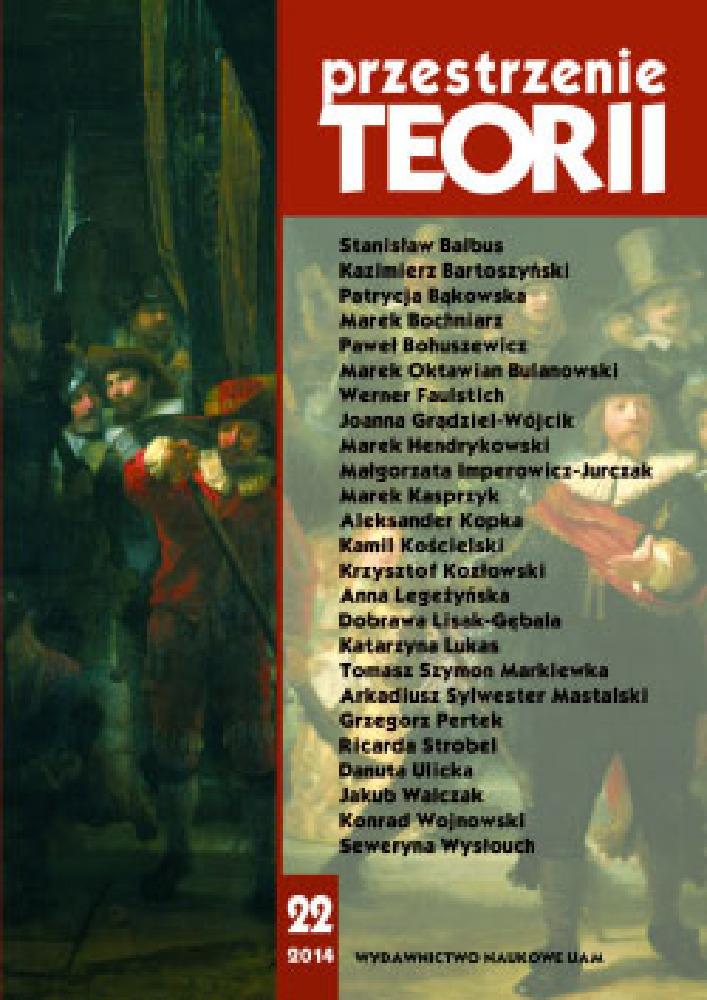Abstrakt
Contemporary Polish essays on paintings and photographs (by, e.g. Z. Herbert, G. Herling-Grudziński, W. Karpiński, J. Pollakówna, E. Bieńkowska, A. Olędzka-Frybesowa, and W. Nowicki) are juxtaposed with the personal essay which was invented by Montaigne. A wide range of commentaries, including ideas about this genre which were expressed by Th. W. Adorno, G. Lukács, and G. Douglas Atkins, provide a theoretical background for the analysis. Selected Polish texts are presented as artistic constructions that recreate the process of experiencing pictures and the movement of thoughts of the essayistic “self” which uses many disguises (e.g. a traveler, amateur, scholar and critic). A particular painting or photo, which is often artfully described by means of ekphrasis, is treated by essayists as a starting point for analyzing many broader issues as well as for indirect self-presentation.Bibliografia
K. Dybciak, Inwazja eseju, „Pamiętnik Literacki” 1977, z. 4, s. 118; A. Zawadzki, Nowoczesna eseistyka filozoficzna w piśmiennictwie polskim pierwszej połowy XX wieku, Kraków 2001, s. 6
R. Sendyka, Nowoczesny esej. Studium historycznej świadomości gatunku, Kraków 2003, s. 171.
C.H. Claus, Toward a collective poetics of essay, [w:] Essayists on the Essay. Montaigne to Our Time, ed. C.H. Claus, N. Stuckey-French, Iowa City 2012, s. XXII
G. Lukács, O istocie i formie eseju. List do Leo Poppera, przeł. R. Turczyn, [w:] Pisma krytyczno-teoretyczne Georga Lukácsa. 1908–1932, wybór i wstęp S. Morawski, Warszawa 1994, s. 91.
M. Krakowiak (Mierzenie się z esejem. Studia nad polskimi badaniami eseju literackiego, Katowice 2013, s. 134.
R. Sendyka, Nowoczesny esej..., s. 142–142, 160; M. Krakowiak, dz. cyt., s. 64, 77–78.
K. Wyka, Porozmawiajmy o essayu, „Odrodzenie” 1947, nr 29; E. Bieńkowska, Sztuka eseju, „Znak” 1976, nr 1; G. Herling-Grudziński, W. Bolecki, Rozmowy w Dragonei, Warszawa 1997, s. 306.
A. Olędzka-Frybesowa, Patrząc na ikony, Warszawa 2001, s. 272.
W. Głowala, Próba teorii eseju literackiego, [w:] Genologia polska, red. E. Miodońska-Brookes, A. Kulawik i M. Tatara, Warszawa 1983;
A.S. Kowalczyk, Kryzys świadomości europejskiej w eseistyce polskiej lat 1945–1977 (Vincenz – Stempowski – Miłosz), Warszawa 1990; Polski esej. Studia, red. M. Wyka, Kraków 1991
Hasła słownikowe: D. Heck, Esej, [w:] Słownik l iteratury polskiej XX wieku, red. A. Brodzka i in., Wrocław 1992; A.S. Kowalczyk, Esej, [w:] Literatura polska XX wieku. Przewodnik encyklopedyczny, red. A. Hutnikiewicz, A. Lam, Warszawa 2000.
R. Sendyka, Nowoczesny esej (część „Czysty Esej”, czyli abstrakcja). red. K. Sauerland, Warszawa 1990.
G.D. Atkins, Tracing the Essay: Through Experience to Truth, Athens–London 2010.
Th.W. Adorno, Esej jako forma, [w:] Sztuka i sztuki. Wybór esejów, przeł. K. Krzemień-Ojak, red. K. Sauerland, Warszawa 1990.
A. Pacholski, Bulwar cieni, w: Brulion paryski, Wrocław 1999.
J.-F. Lyotard, Wzniosłość i awangarda, przeł. M. Bieńczyk, „Teksty Drugie” 1996, nr 2–3.
A. Huxley, [From the preface to collected essays], [w:] Essayists on the Essay…, s. 89.
E. Kuryluk, Artystki i bęcwały, [w:] tejże, Art mon amour. Szkice o sztuce, Warszawa 2002.
H. Waniek, Martwa natura z niczym. Szkice z lat 1990–2004, Kraków 2004.
K. Szalewska, Pasaż tekstowy. Czytanie miasta jako forma doświadczania przeszłości we współczesnym eseju polskim, Kraków 2012.
S. Levine, The self on the shelf, [w:] Essayists on the essay…
Z. Herbert, Barbarzyńca w ogrodzie, Warszawa 2004, s. 128.
V. Woolf, The Modern Essay, [w:] tejże, The Common Reader, London 1948, s. 281.
W. Zalewski, Zwiadowcy światła, Warszawa 1999, s. 18.
J. Iwaszkiewicz, Podróże do Włoch, Warszawa 2008, s. 93.
Z. Herbert „Mistrz z Delft” i inne utwory odnalezione, red. B. Toruńczyk, Warszawa2008, s. 55.
G. Herling-Grudziński, Sześć medalionów i srebrna szkatułka, Warszawa 1994, s. 35, 90.
M. Bryl, Suwerenność dyscypliny. Polemiczna historia historii sztuki od 1970, Poznań 2008, s. 433–486, 580–621.
J. Pollakówna, Weneckie tęsknoty, Warszawa 2003, s. 10.
The Passionate Sightseer: From the Diaries by Bernard Berenson, 1947–56, New York 1960.
E.B. White, [From the foreword to essays of E. B. White], [w:] Essayists on the essay…, s. 105.
A. Dziadek, Apologia twórczej swobody. Eseje Zbigniewa Herberta: opis – uobecnienie – interpretacja, [w:] Zmysł wzroku, zmysł sztuki. Prywatna historia sztuki Zbigniewa Herberta, red. J.M. Ruszar, cz. 2, Lublin 2006.
D. Lisak-Gębala, „Energia” metafor w ekfrazach eseistycznych, „Pamiętnik Literacki” 2011, z. 3.
V. Cunningham, Why Ekphrasis?, „Classical Philology” 2007, vol. 102, no. 1, s. 60–61.
W. Karpiński, Amerykańskie cienie, Warszawa 2013, s. 64–65.
S. Cheeke, Writing for Art: The Aesthetics of Ekphrasis, Manchester 2010, s. 2.
Licencja
Autorzy
Autorzy tekstów przyjętych do publikacji w czasopiśmie „Przestrzeniach Teorii” są zobowiązani do wypełnienia, podpisania i odesłania na adres redakcji umowy o udzielenie nieodpłatnej licencji do utworów, z zobowiązaniem do udzielania sublicencji CC.
Zgodnie z umową, autorzy tekstów opublikowanych w czasopiśmie „Przestrzeniach Teorii” udzielają Uniwersytetowi im. Adama Mickiewicza w Poznaniu niewyłącznej i nieodpłatnej licencji oraz zezwalą na użycie sublicencji Creative Commons Attribution-NonCommercial-NoDerivatives 4.0 International (CC BY-NC-ND 4.0).
Autorzy zachowują prawa do dalszego, swobodnego rozporządzania utworem.
Autorzy, którzy wykorzystują w swoim tekście cudze utwory (np. ilustracje, fotografie) proszeni są o dostarczenie do redakcji czasopisma zgodę na publikację od uprawnionych podmiotów.
Użytkownicy
Zainteresowani użytkownicy internetu uprawnieni są do korzystania z utworów opublikowanych po 2015 roku „Przestrzeniach Teorii” tylko w calach niekomercyjnych, pod następującymi warunkami:
- uznanie autorstwa - obowiązek podania wraz z rozpowszechnionym utworem, informacji, o autorstwie, tytule, źródle (odnośniki do oryginalnego utworu, DOI) oraz samej licencji;
- bez tworzenia utworów zależnych - utwór musi być zachowany w oryginalnej postaci, nie można bez zgody twórcy rozpowszechniać np. tłumaczeń, opracowań.
Do wszystkich tekstów opublikowanych przed 2015 r. prawa autorskie są zastrzeżone.
Inne
Uniwersytet im. Adama Mickiewicza w Poznaniu zachowuje prawo do czasopisma jako całości (układ, forma graficzna, tytuł, projekt okładki, logo itp.).
